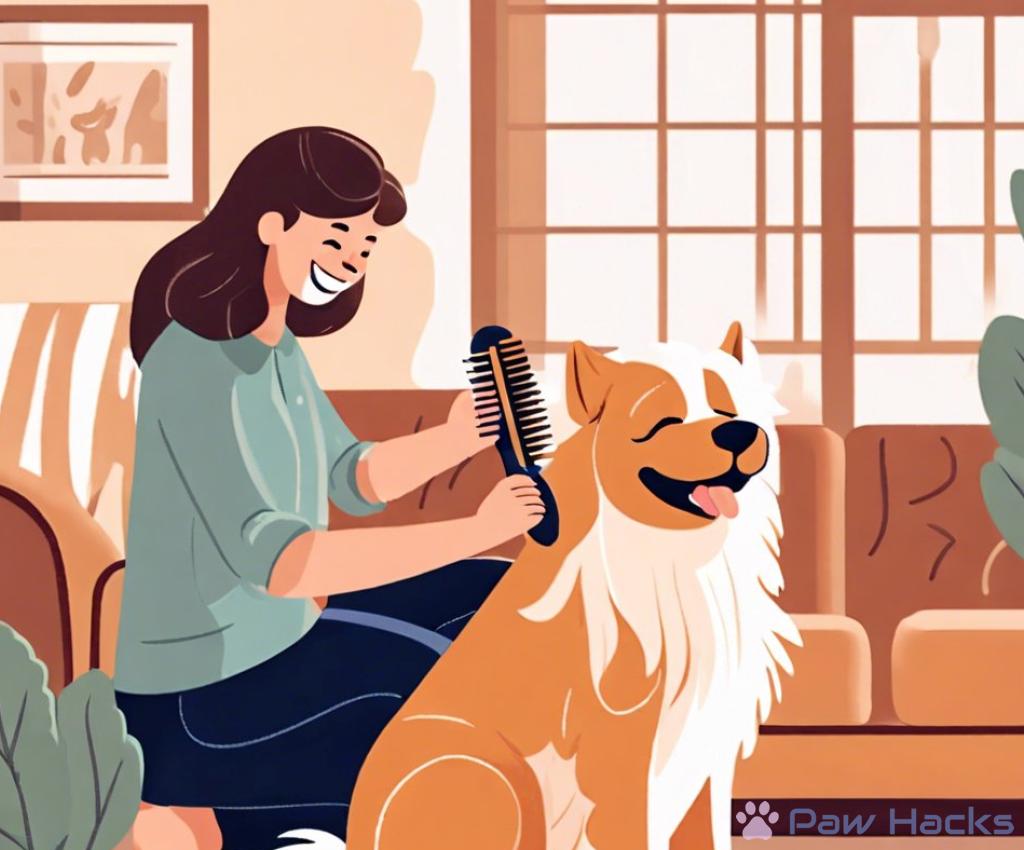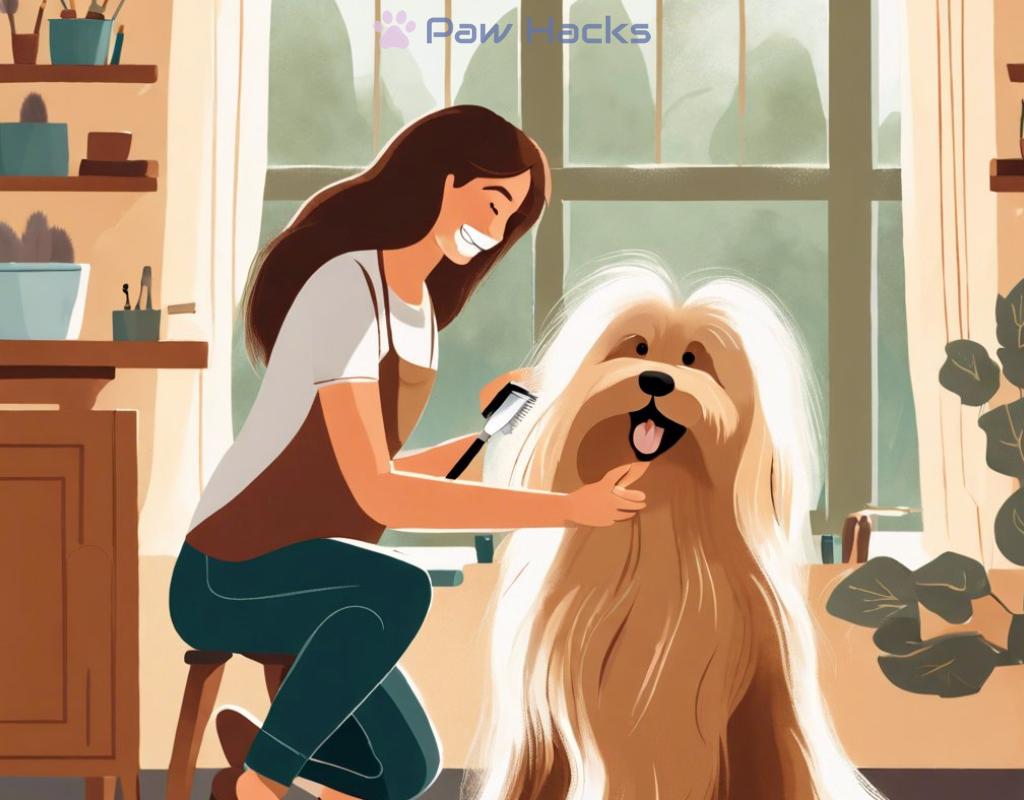Brushing Out Tangles in Long-Haired Dogs
Mastering the Art of Gentle Grooming: Techniques to Untangle Your Dog’s Fur

Grooming your long-haired dog is not just about keeping them looking beautiful; it’s essential for their health and comfort. Regular brushing helps remove dirt, debris, and dead hair, while also preventing painful tangles and mats. Maintaining a consistent grooming routine can significantly reduce the time and effort needed to tackle those pesky knots.
Before you dive into the untangling process, it’s crucial to recognize the different types of tangles that can form in your dog’s coat. Understanding these can help you choose the right technique and tools for the job.
| Tangle Type | Description |
|---|---|
| Surface Tangles | Small knots on the surface of the coat that are relatively easy to remove. |
| Matting | More severe tangles that can pull at the skin and cause discomfort. |
| Fleece Tangles | Loose, fluffy tangles that require gentle brushing to avoid damaging the coat. |
Untangling your dog’s fur should always be done with care to prevent hurting their skin or causing stress. Here are some effective techniques to help you master the art of gentle grooming:
- Start with the Right Tools: Invest in high-quality grooming tools, such as wide-toothed combs, slicker brushes, and detangling sprays.
- Work in Sections: Divide your dog’s coat into manageable sections to avoid overwhelming both you and your pet.
- Be Gentle: Always start brushing from the ends of the hair and work your way up to the root, using your fingers to gently pull apart knots.
- Use Detangling Products: Applying a detangling spray can make the process smoother and less painful for your dog.
- Reward Your Dog: Keep the experience positive by rewarding your dog with treats and praise during and after grooming sessions.
Essential Tools for Brushing Long-Haired Dogs: What You Need for a Smooth Experience
When it comes to grooming long-haired dogs, having the right tools can make all the difference. The right equipment not only simplifies the grooming process but also ensures your furry friend remains comfortable and stress-free. Whether you’re dealing with surface tangles or more stubborn mats, investing in quality grooming tools is essential for a smooth experience.
To effectively brush out tangles and maintain the beauty of your dog’s coat, here are the must-have tools:
- Slicker Brush: Ideal for removing loose hair and tangles, this brush has fine, short wires close together on a flat surface, making it effective for detangling.
- Wide-Toothed Comb: Perfect for gently working through knots without pulling on your dog’s skin. This tool is excellent for finishing off after using a slicker brush.
- Detangling Spray: A special formulation that helps to loosen knots and makes brushing easier. It can prevent breakage and keep your dog’s coat shiny.
- Dog Grooming Gloves: These allow you to brush your dog while petting them, making it a more enjoyable experience for both of you.
- Mat Splitter: For those stubborn mats that refuse to budge, a mat splitter can help cut through the toughest tangles without harming your dog’s skin.
Not all long-haired dogs have the same coat type, and understanding these variations can help you choose the best tools for grooming. Here’s a brief overview:
| Coat Type | Recommended Tools | Grooming Frequency |
|---|---|---|
| Straight Hair | Slicker Brush, Wide-Toothed Comb | 2-3 times a week |
| Wavy Hair | Slicker Brush, Detangling Spray | Every other day |
| Curl Hair | Mat Splitter, Grooming Gloves | Daily |
Alongside the right tools, creating a calm and comfortable grooming space is crucial for a successful session. Make sure to choose a quiet area free from distractions, and consider playing soft music to help keep your dog relaxed. Always approach grooming as a bonding experience; use treats and praise generously to create positive associations with the process.
Preventing Tangles: Tips for Maintaining Your Dog’s Luxurious Coat
Maintaining a long-haired dog’s beautiful coat requires more than just occasional brushing; it calls for a proactive approach. By implementing a few simple practices into your routine, you can significantly reduce the formation of tangles and keep your furry friend looking their best. Here are some effective strategies to help keep your dog’s coat free from knots and maintain its luxurious quality.
Consistent care is crucial in preventing tangles before they start. Establishing a daily grooming routine can help you stay ahead of any potential issues. Even if your dog doesn’t appear to be tangled, taking a few minutes each day to brush their coat can prevent mats from forming and will promote healthy skin and fur.
A well-hydrated and balanced diet plays a significant role in the health of your dog’s coat. Ensuring your dog drinks enough water and receives the right nutrients can enhance the quality of their fur, making it less prone to tangling. Regularly incorporating Omega fatty acids into their diet can also promote a shiny and healthy coat.
To further aid in preventing tangles and mats from forming, consider the following tips:
- Regular Bathing: Bathe your dog with a quality dog shampoo formulated for their coat type. Clean fur is less likely to attract dirt and debris that can lead to tangling.
- Use Conditioning Products: After bathing, apply a dog-safe conditioner to help keep the coat moisturized and manageable.
- Keep Your Dog’s Environment Hair-Free: Regularly clean your dog’s sleeping area and play spaces to reduce the accumulation of hair and dirt that can contribute to tangles.
- Invest in Grooming Tools: Ensure you have the right tools on hand, including brushes and combs suited for your dog’s coat type, to make maintenance easier and more effective.
By incorporating these practices into your grooming routine, you can enjoy a healthy, luxurious coat that not only looks great but also keeps your dog comfortable and happy.
Understanding Your Dog’s Coat Type: Tailoring Your Brushing Approach
Every long-haired dog has a unique coat type that requires specific grooming techniques to keep it looking its best. Understanding your dog’s coat can transform the often daunting task of brushing into an enjoyable bonding experience. By recognizing the characteristics of your dog’s fur, you can tailor your grooming approach, ensuring not only a beautiful coat but also a comfortable experience for your furry friend.
Different coat types present various challenges and advantages when it comes to grooming. For instance, straight hair is typically easier to manage, as it tends to resist matting. In contrast, wavy and curly coats can trap dirt and debris more readily, leading to tangling if not cared for properly. Each coat type has its own grooming requirements, making it essential to understand what works best for your dog’s unique fur.
| Coat Type | Common Traits | Recommended Grooming Tools |
|---|---|---|
| Straight Hair | Minimal matting, easy to brush | Slicker Brush, Wide-Toothed Comb |
| Wavy Hair | More prone to tangles, requires regular attention | Slicker Brush, Detangling Spray |
| Curl Hair | Very prone to matting, needs frequent grooming | Mat Splitter, Grooming Gloves |
Understanding your dog’s specific coat type allows you to customize your grooming routine effectively. For dogs with straight hair, a simple routine of brushing 2-3 times a week suffices. The use of a slicker brush followed by a wide-toothed comb can help keep their coat smooth and free from knots. On the other hand, wavy-haired dogs benefit from more frequent grooming, ideally every other day. Utilizing a slicker brush in conjunction with a detangling spray will help manage their waves and prevent tangles before they form.
For those with curly coats, daily grooming is non-negotiable. The use of a mat splitter alongside grooming gloves can make the process more enjoyable. Curly fur can be particularly sensitive, so being gentle while working through mats is crucial. Additionally, maintaining a consistent routine not only improves the coat’s appearance but also enhances your dog’s comfort and happiness.
Ultimately, customizing your approach based on your dog’s coat type not only simplifies the grooming process but also helps forge a deeper bond with your furry companion. Understanding the nuances of their fur allows you to provide the best care possible, ensuring they remain comfortable and stylish.
The Ultimate Tangle-Busting Routine: Step-by-Step Guide for Long-Haired Dogs
Before diving into the actual grooming process, it’s essential to set the stage for a successful session. An inviting and calm grooming environment can significantly impact your dog’s comfort and willingness to cooperate. Choose a quiet spot with ample lighting, and consider laying down a soft blanket or mat where your dog can sit comfortably. Additionally, gather all your grooming tools within reach, ensuring everything is organized and ready to go. This preparation not only helps make the process smoother but also fosters a sense of security for your furry friend.
Now that you’ve established a welcoming environment, it’s time to tackle those tangles with a systematic approach. Following a step-by-step routine can help you efficiently remove knots while keeping your dog calm and relaxed. Begin by gently inspecting your dog’s coat, looking for areas of concern, particularly around the ears, underbelly, and behind the legs, where tangles often form. Use your fingers to separate the hair before reaching for your tools.
Start with a slicker brush, which is excellent for loosening surface tangles. Work in small sections, brushing from the tips of the hair and gradually moving upward toward the roots. This technique minimizes pulling and discomfort. If you encounter a stubborn knot, switch to a wide-toothed comb to gently work through it. Remember, patience is key; take your time and offer treats or praise to reassure your dog throughout the process.
For more severe mats, especially in curly or wavy coats, you may need to employ a mat splitter. Carefully insert the splitter into the mat and gently pull apart the hair without tugging on the skin. Always remember to check in with your dog, ensuring they are comfortable and not stressed. If you notice signs of discomfort, pause, offer a break, or switch to a gentler technique.
After successfully tackling the tangles, it’s time for the finishing touches. Use a detangling spray to help maintain the coat’s health and shine. Lightly mist the coat and follow up with the slicker brush to distribute the product evenly. This final step not only enhances the coat’s appearance but also helps prevent future tangles.
As part of your ongoing maintenance routine, schedule regular grooming sessions, ideally every few days, to keep tangles at bay. Establishing this habit will create a positive experience for both you and your dog, ensuring they remain comfortable and happy. A well-groomed coat is not only beautiful but a reflection of your love and care for your furry companion.
Share this content:



